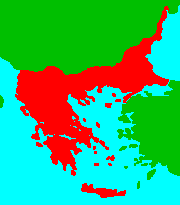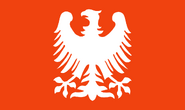The Sacharid Empire is a country situated in Europe, the Middle East and northern Africa. As of the 2039 census, its population was 323,174,857.
History[]
Origins[]
The Sacharid Empire is descended from the Sacharid people that inhabited what is now Venice and parts of the northern Balkans between 1700 and 150 BCE.
Beginnings[]
In 1780 BCE, the Sacharid bronze age culture migrated into the territory which they would inhabit for the next four centuries. Their population was low initially at just 150,000 in 1700 BCE.
The rise[]
In 1500 BCE, the Sacharid Bronze Age culture adopted bronze tools and weapons, which allowed them to take huge amounts of territory and make effective use of the land. By 1350 BCE, there were 2.5 million of them, and an estimated force of 15,000.
Peak[]
In 1200 BCE, the Sacharid Bronze Age culture collapsed due to the influence of Iron Age cultures, resulting in a temporary dip in the population, and around 1100 BCE the Sacharid Iron Age culture formed.
The massive amounts of territory taken and the required manpower to keep that territory meant that the Sacharids could not take much more land, and the constant threat of enemies resulted in consistent losses of land.

Sacharid Iron Age culture in 750 BCE. Western Sacharid people shown in orange, Eastern Sacharid people shown in red
The Sacharid culture continued to grow though, creating primitive cities and growing to 6 million people by 900 BCE.
By 750 BCE, there was already a loose confederation, this meant that the Sacharid culture could continue expanding its land again.
| City name | Population (~900 BCE) |
|---|---|
| Kā'dak, Pruijo, Krísa | ~10,000 |
| Vokini | ~8,000 |
| Sēdro, Vÿrú and 4 other cities | ~5,000 |
Decline[]
Around 700 BCE, the population of the Sacharid culture was 9.5 million, putting a massive stress on the food supplies due to the farming ways of the Sacharids, which were much less efficient than other cultures. The Sacharid culture was quick to implement them, but it resulted in mass starvation, famine and epidemics anyway, cutting the Sacharid population to 3 million by 550 BCE.
The reduced population was no longer able to defend its territory, and enemy tribes cut into its territory, resulting in even fewer people, which was only stopped by repeated seasons of good harvests.
By 450 BCE, the situation became so bad that the Sacharid people made a centralized empire, copying a Greek-style government that improved administrative capability, military power and census-taking.
Proto-empire[]
The Sacharid people eventually created a loose confederation, then a more centralized state by 400 BCE. The new state reached its maximum extent by 250 BCE. Eventually, internal conflicts weakened the state to the point where the state collapsed in 184 BCE, leaving two smaller states that managed to unify together in 157 BCE.

Sacharid proto-empire in 140 BCE
A golden age started in 140 BCE, when the Sacharid state stopped an attempted invasion and conquered large amounts of territory, becoming a new superpower. This would not last though and by 96 BCE, the Sacharid state split into three states, this time for good.
The states were easy pickings for stronger states, and the western state fell first to the Roman Republic in 90 BCE. The eastern state was conquered in 28 BCE, leaving only the northern state, which survived until 384 CE.
Language[]
The Western Sacharid people spoke the ancient Sacharid language, which was first deciphered in 1784. Most of the deciphered text comes from the Eastern Venice fragment, which was made sometime between 198 and 185 BCE.
History[]
The Sacharid language started around 2000 BCE. In this time, it evolved through various stages, first the Proto-Sacharid language, which evolved from proto-language around 2000 BCE and went extinct by 800 BCE, the first Sacharid language, which appeared around 1000 BCE and went extinct around 300 BCE, and the second Sacharid language, which appeared around 450 BCE and went extinct in 720 CE.
Translation[]
The first ancient Sacharid text to be deciphered was a message from King Karov (213-180 BCE) sent to the Roman Republic.

The original text of the Sacharid language, with some Eastern Sacharid language (Fragment 12)
Original Sacharid text: narāko'eranō karwan, novre vuzōn.
Translation (1990): Come and meet us any time, we shall accept you.
The Eastern Sacharid language is still undeciphered, and most of its evidence comes from the Eastern Venice fragment.
By 2017, there are 12,780 fragments of the ancient Sacharid language and over 80,000 fragments of the Eastern Sacharid language.
Medieval state[]
Migration[]
The Sacharids, having lost their homes, started to migrate south towards what is now Greece. They eventually settled here for the rest of their existence. By 600, the Sacharids had firmly placed themselves in Greece, and began mixing in with the local population so much that by 1000, they were practically indistinguishable from the locals.
Original empire[]

Sacharid Empire in 1350
The original Sacharid Empire was founded in 1225, taking advantage of the aftermath of the Fourth Crusade, taking Constantinople, renamed as Sacharidia. The new empire had matters to deal with, including conquering the remaining remnant states. The Sacharid Empire reached its maximum extent by 1350, and then started a slow decline, being weakened by conflicts with its neighbors, mainly the Ottoman Empire. By 1506, the Sacharid Empire was no more.
Modern state[]
Revolt[]
Main article: 2nd Sacharid Revolt
The 2nd Sacharid Revolt was a failed attempt at restoring the Sacharid Empire, though certainly the most successful by a country mile. It started in November 1916 with an occupation of Thessaloniki and southern Bulgaria, and reached its peak by July 1917. After the failed Battle of Constantinople, the revolt ended in April 1918.
World War II[]
In 1941, a puppet Sacharid state was created from parts of German-occupied Yugoslavia and all of Italian-occupied Greece and Albania. It existed until March 1945 when it was occupied by the Allies.
Present day[]
In 1946, after World War II, a new Sacharid state was formed by the Soviet Union and promptly became a puppet of it. In 1960, the Sacharid Empire successfully revolted against the Soviet Union and left the Warsaw Pact in favor of a more democratic state, though it is good to note that the "democratic" state was almost immediately seized by right-wing parties.
Today, it is a highly advanced economic power, with a large population, massive industrial capacity and a professional army.
Flags[]
| Sacharid Empire | |||||
| |||||
Sacharid Empire in 2017
| |||||
Sacharid Empire at maximum extent (2040)
| |||||
| Capital | Sacharidia | ||||
| Largest city | Sacharidia | ||||
| Official languages | N/A | ||||
| Religion | N/A | ||||
| Government | Not specified | ||||
| History | |||||
| - | Founded | 1225 | |||
| - | Fall of Sacharidia | September 6, 1506 | |||
| - | 1st Sacharid Revolt | February 24, 1891 | |||
| - | 2nd Sacharid Revolt | 1916-1918 | |||
| - | Independence Day | June 7, 1946 | |||
| - | Sacharid Revolution of 1960 | May - June 1960 | |||
| - | Great Sacharid Revolt | 2028 | |||
| Area | |||||
| - | Total | 4,100,000 km² (1,583,019 sq mi) | |||
| - | 1283 | 7,000 km² (2,703 sq mi) | |||
| - | 1384 | 121,400 km² (46,873 sq mi) | |||
| - | 1459 | 16,700 km² (6,448 sq mi) | |||
| - | 2017 | 250,000 km² (96,526 sq mi) | |||
| Population | |||||
| - | 2039 | 323,174,857 | |||
| Density | 78.8/km² (204.2/sq mi) | ||||
| - | 1283 | 121,400 | |||
| Density | 17.3/km² (44.9/sq mi) | ||||
| - | 1384 | 3,170,000 | |||
| Density | 26.1/km² (67.6/sq mi) | ||||
| - | 1459 | 685,100 | |||
| Density | 41/km² (106.3/sq mi) | ||||
| - | 2017 | 30,700,000 | |||
| Density | 122.8/km² (318.1/sq mi) | ||||
| GDP (nominal) | 2036 | ||||
| - | Total | US$6,909,155,000,000 | |||
| - | Per capita | US$21,379 | |||
| Gini (2038) | 42.6 medium | ||||
| HDI (2036) | very high | ||||
| Time zone | UTC +1, 2, 3 | ||||
| - | Summer (DST) | UTC +2, 3, 4 | |||
| Drives on the | Right | ||||
| Calling code | +93 | ||||
| ISO 3166 code | SC, SCH | ||||
| Internet TLD | .sc | ||||
The flag of the Sacharid puppet state, the Sacharid SSR and the first Sacharid flag are in a 3:5 ratio, while the current Sacharid flag is in a 2:3 ratio.
The flag of the Sacharid SSR is quite similar to the latter flags, with the only differences being that the eagle is slightly smaller and the presence of a hammer and sickle. The Sacharid puppet state is the same as the first Sacharid flag but with four Iron Crosses.
Economy[]
As of 2036, the GDP of the Sacharid Empire was $6.909 trillion, and its GDP per capita (nominal) was $21,379.
According to the Comprehensive Economic Report for the Sacharid Empire (2037), its main exports were oil (16.3%), iron ore (9.5%) and cobalt (7.5%), while its main imports were general components (10.3%), automobiles (8.7%) and electronics (7%).
The GDP grew by 2.6% between 2035 and 2036.
As of 2039, its national debt was $2.383 trillion.
Politics[]
Main article: Politics of Sacharid Empire
Demographics[]
As of the 2039 census, there were 323,174,857 people, of which 297,485,039 people had permanent citizenship.
The average population growth rate in 2039 was 2.1%, of which the fastest growing was the Egypt region with 4.7% growth, and the fastest declining was the Northern Balkans region with -0.3% growth.
The percentage of people below the poverty line was 5.1%.
15.3% of the population was below 18, 67.1% of the population was between 18 and 65, and 17.6% of the population was above 65.
Transport[]
Main article: Transport of Sacharid Empire







